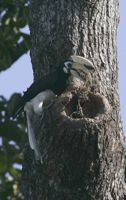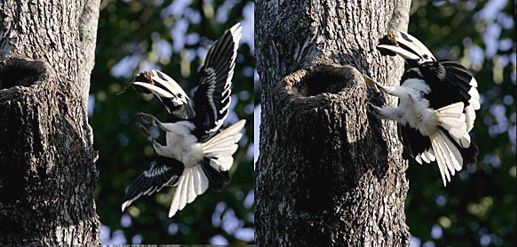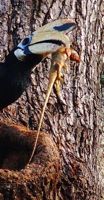On 8th February 2007 the female Oriental Pied Hornbill (Anthracoceros albirostris) found the cavity in the Shorea gibbosa tree suitable and entered it. Then she began the slow process of sealing herself inside. We thought that she was then ready to settle down and lay her eggs. But that was not to be. For the next 13 days up to 21st February, the male was still bring her lumps of mud together with grass stems (left) for her to fortify herself inside the cavity.
It has been reported that she would mix the mud with her droppings and any uneaten food to construct the barrier. Obviously this was hard work and she needed to be fed. Unlike other species of hornbills, the female Oriental Pied does not leave the nest during this period.
Thus the female inside needed to be fed. In between bringing mud (above), the male brought figs and other seasonal fruits (below). From samples found below the tree and from photographs, Angie Ng managed to identify the figs to be either Ficus stricta or F. kerkhoveni and the orange-looking fruits to be Bhesa robusta.
During the morning observations, the male was seen bringing fruits at intervals of about 20-30 minutes. He passed the fruits to her after regurgitating them, about five to six times a visit. The seeds on the upper right image are those of Bhesa robusta while the lower right show Bhesa together with figs. [The two smaller pinkish seeds have now been identified by Angie as those of the MacArthur palm (Ptychosperma macarthurii).]
Fruits appear to be the main food at that stage, although there were occasions when insects were brought, including a beetle and a praying mantis.
Besides a snail shell reported earlier, he also brought a shell of a land snail as well as a whole land snail. In this case he cracked open the garden snail and the contents fell into the open bill of the female.
Twice he brought her a lizard, one of which was identified as a Changeable Lizard (left). This last piece of morsel was brought on 12th February and offered to the female. She refused both lizards, one of which was rather large. The male in one instance flew off to a nearby tree and must have eaten it himself. In the other instance, he flicked the lizard around, tossed it into the air and caught it with his bill. This went on for a fair number of minutes, before he flew off to the tree opposite to consume the lizard as previously.
One of the lizards was caught from just above the nest. He was looking down at the female when he suddenly leapt up to a parakeet’s nest one branch above and caught it.
Input by KC Tsang, Meng and Melinda Chan and Angie Ng. Images by Chan Yoke Meng except fruits/seeds by Angie and hornbill with lizard by KC.














4 Responses
the two red/pinkish seeds are fruits of the Macarthur Palm